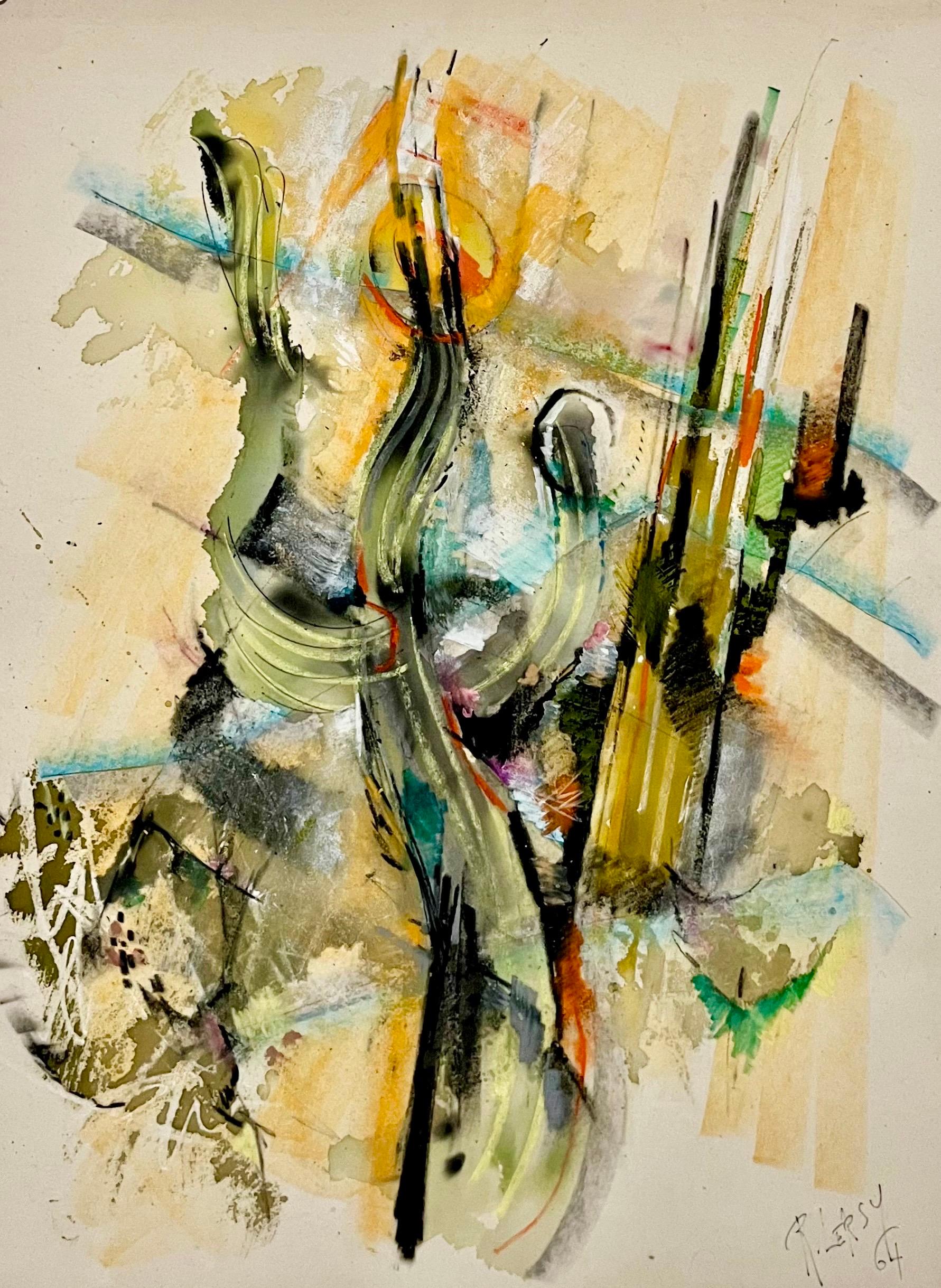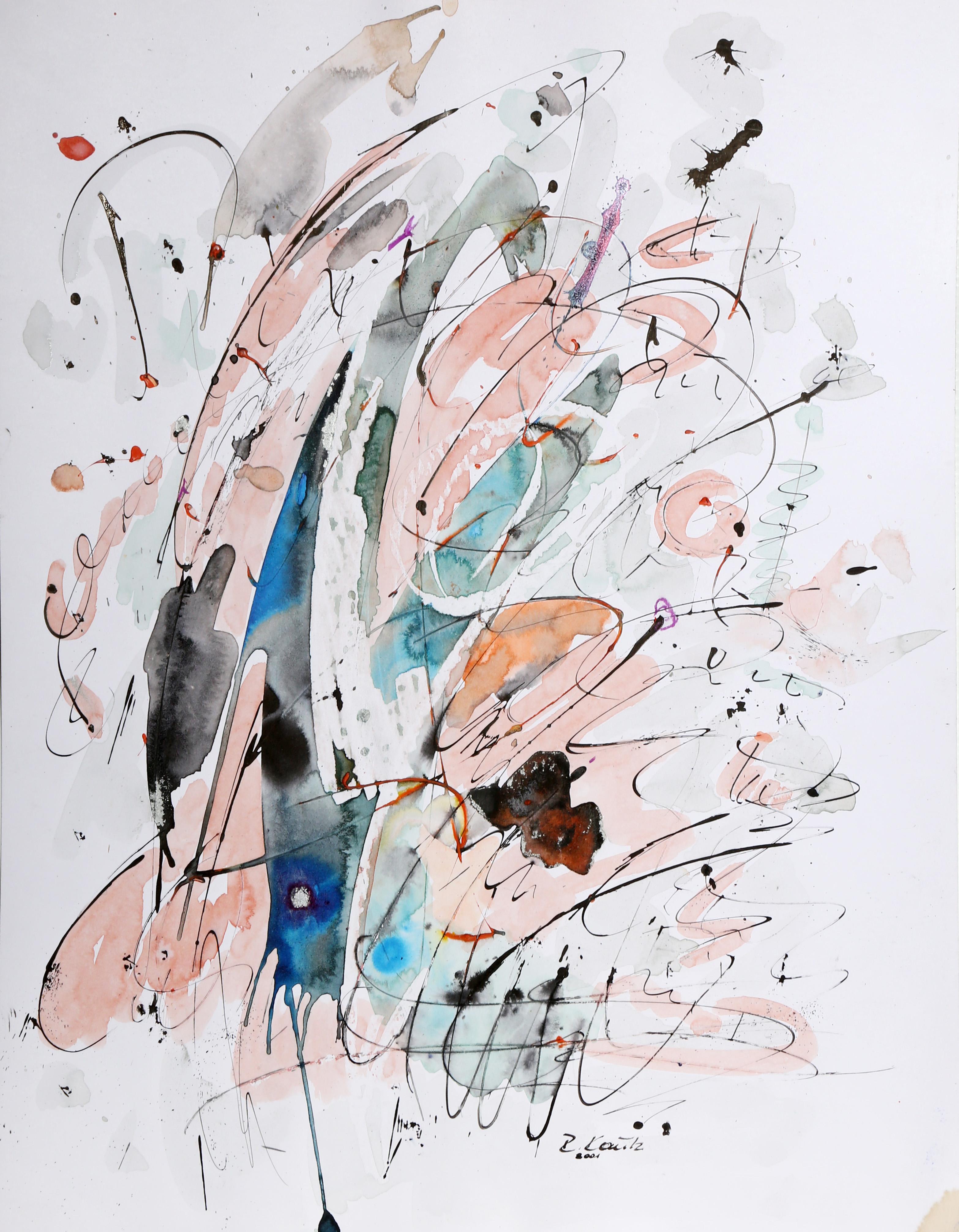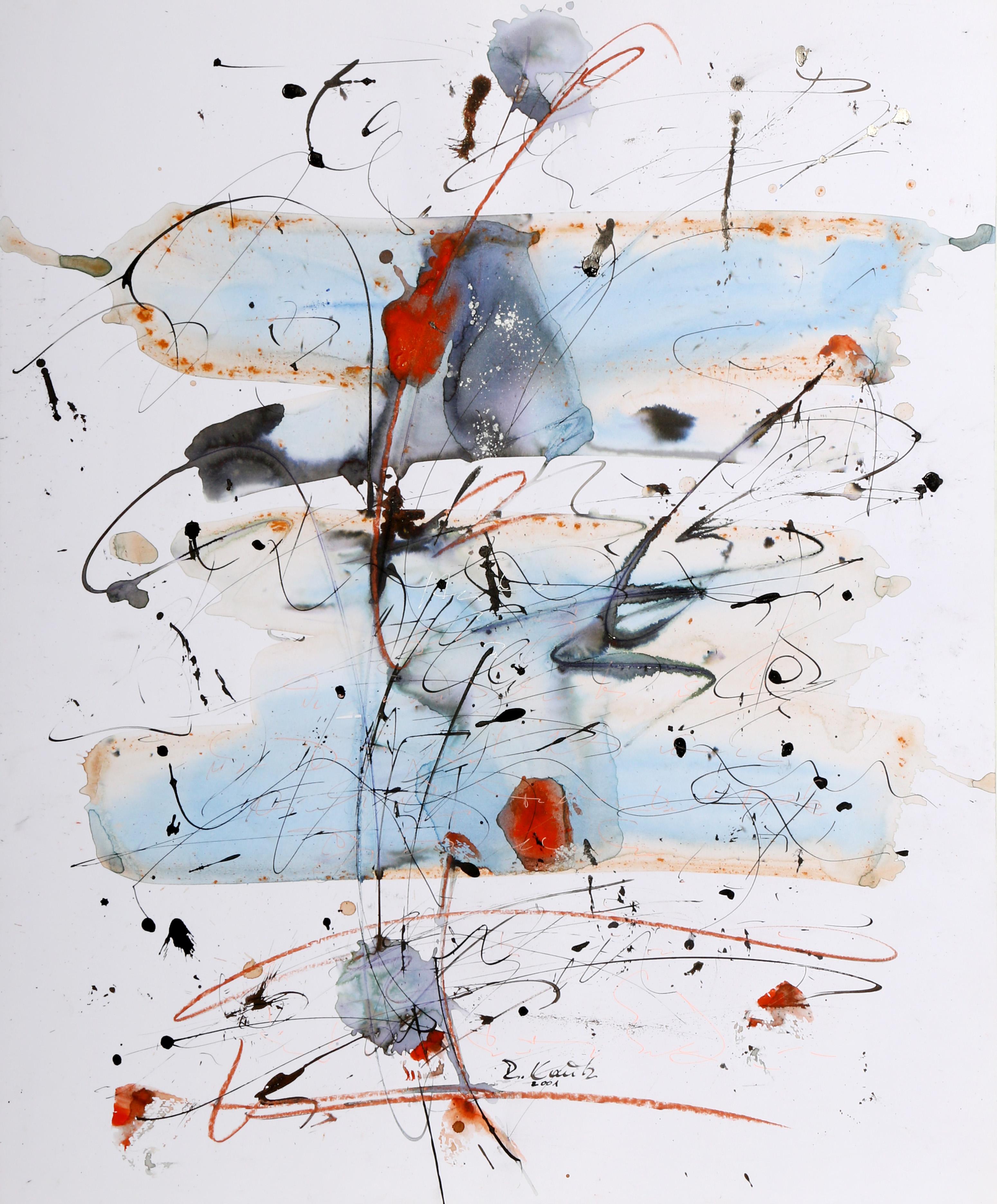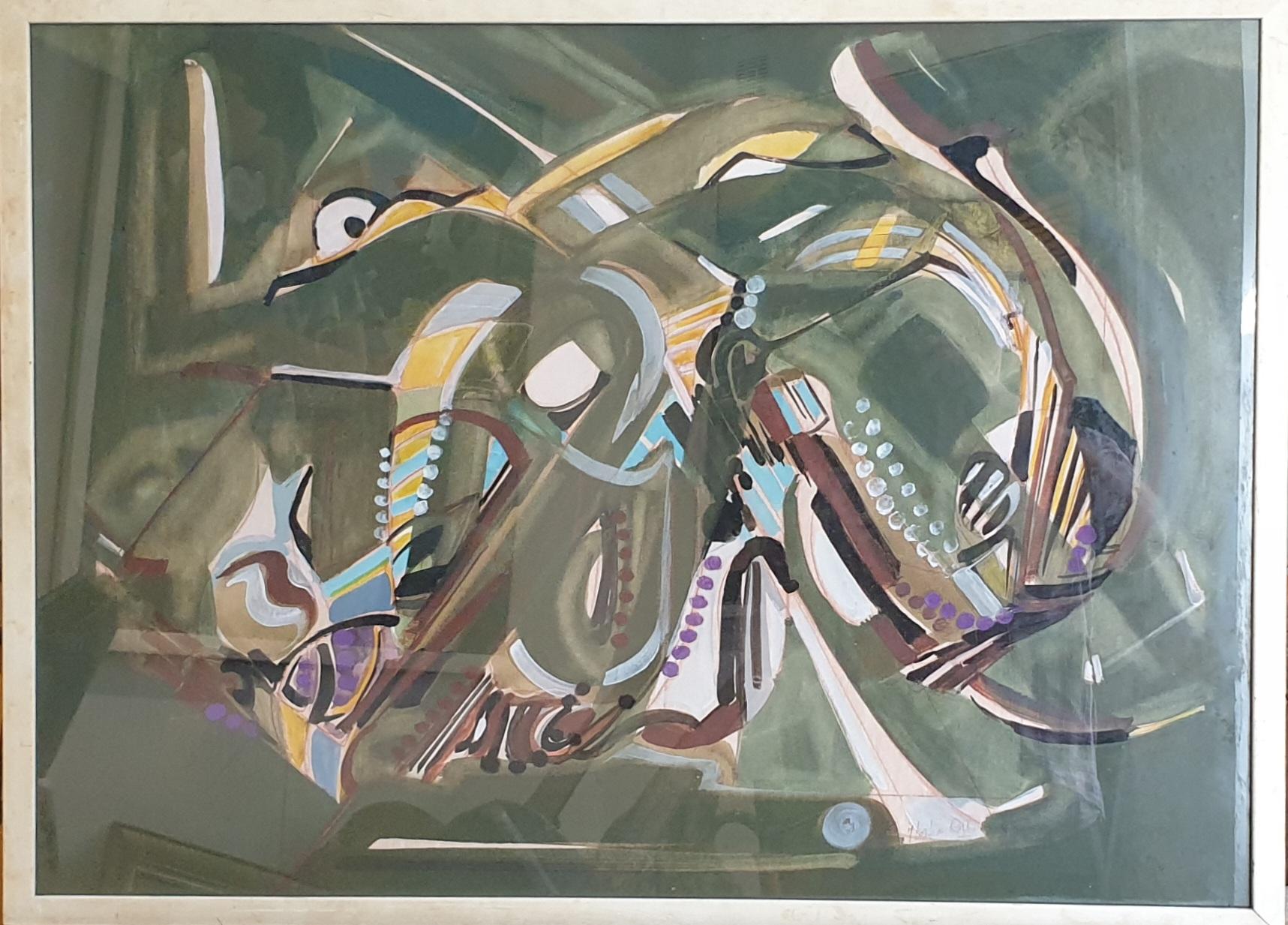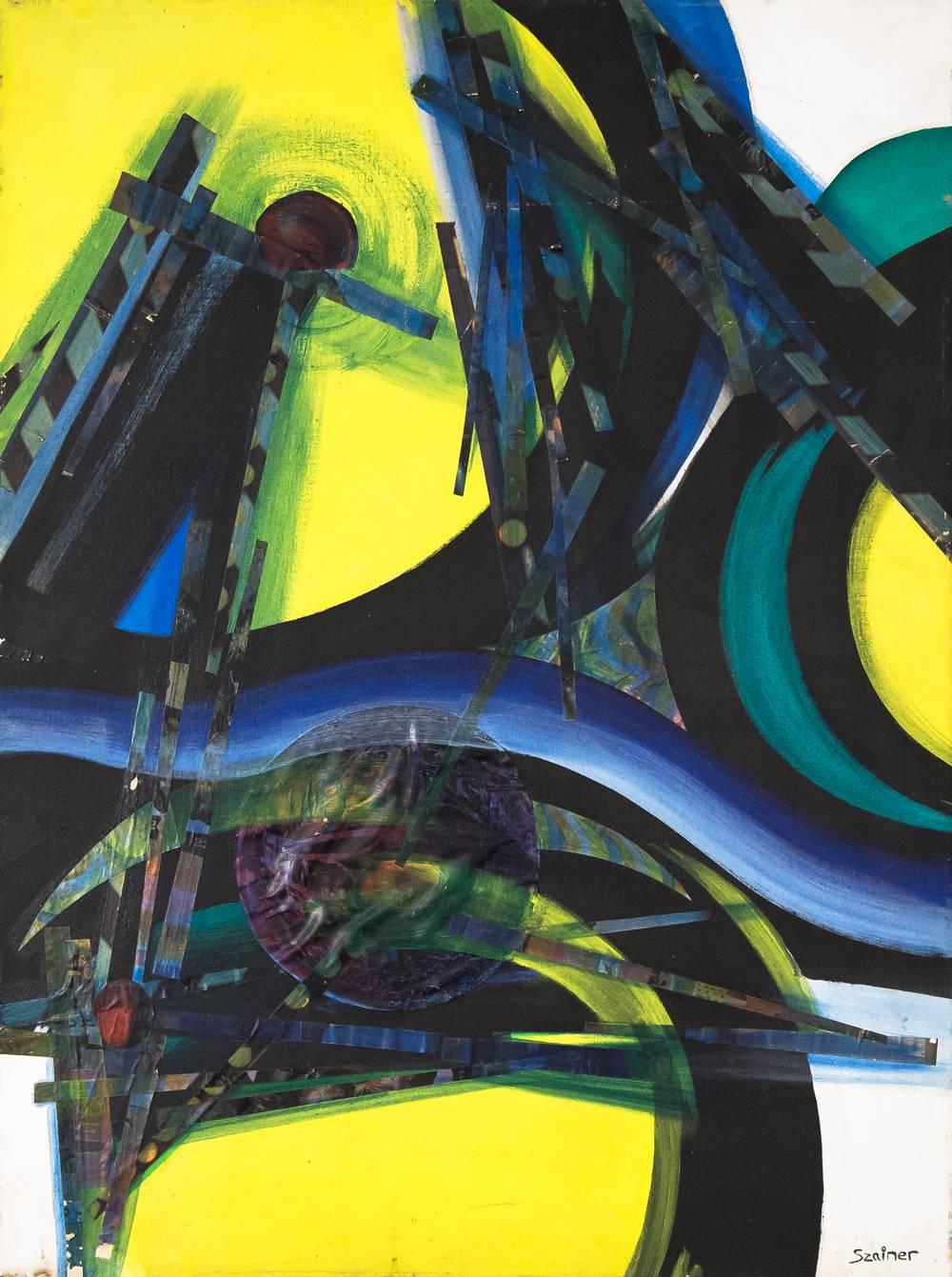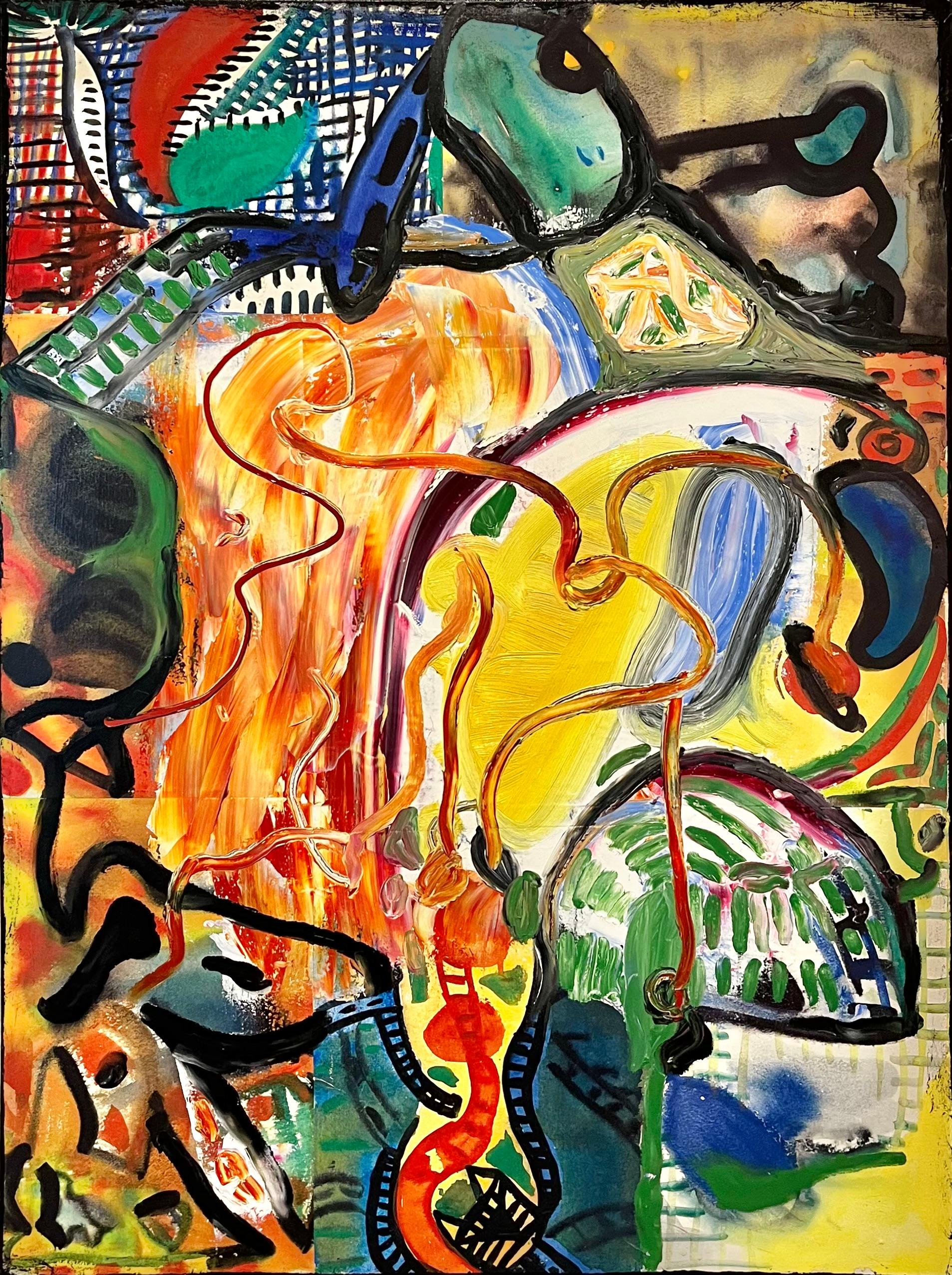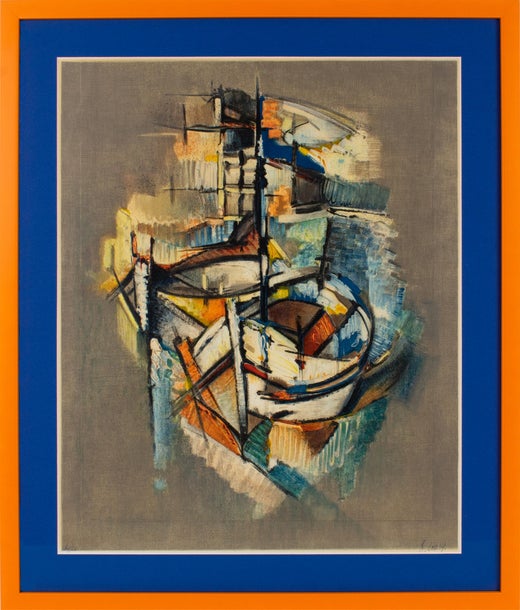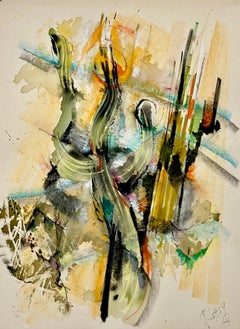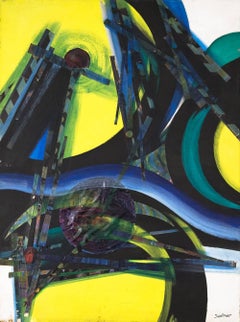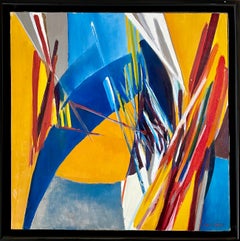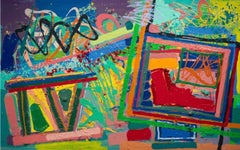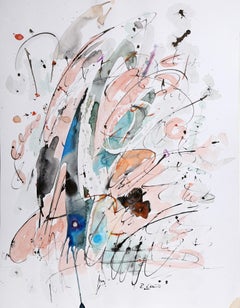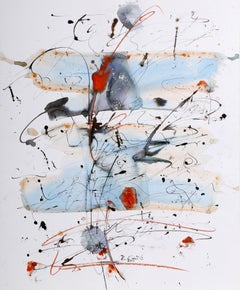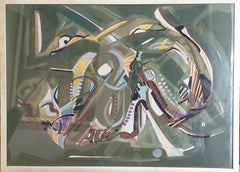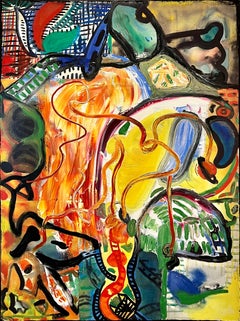Items Similar to Large Modernist Art French Abstract Expressionist Colorful Painting Roger Lersy
Want more images or videos?
Request additional images or videos from the seller
1 of 8
Roger LersyLarge Modernist Art French Abstract Expressionist Colorful Painting Roger Lersy1964
1964
$2,600
£1,980.77
€2,260.53
CA$3,653.62
A$3,981.80
CHF 2,108.53
MX$47,825.58
NOK 26,694.50
SEK 24,542.97
DKK 16,883.62
About the Item
Roger Lersy, French (1920 - 2004)
Painting on paper (not sure if this is watercolor, acrylic or oil, the paper has a velvet finish and texture to it and there is some texture to the paint)
Hand signed, R. Lersy, dated 1964
Measuring 26 X 20 inches
Roger Lersy was born in Paris, France 1920, in the rough neighborhood surrounding Place Pigalle. His youth was marked by extreme poverty. Lersy studied art and music at the École des Arts Apppliqués. He was a painter, lithographer and musician-composer He belongs to the École de Paris and was a member in the movement of the Young Painting. By 1946, when he first exhibited in Paris, Lersy became one of the founders of the School of Paris’ New Graphic School. Lersy received the Prix des Amateurs d’Art in 1953, the Shell Prize in 1954 and the Grand Prize of the City of Marseilles in 1953. Lersy could be defined as a Baroque expressionist. For Bernard Dorival, Roger Lersy is along with Gabriel Dauchot, Jean Commère and Raymond Guerrier among "the most noted champions of this expressionism which is part of the continuation of Bernard Buffet's miserabilism".
Famous works:
New Year's Eve , Aubusson tapestry of the Manufacture des Gobelins , Permanent Mission of France to the United Nations , One Dag Hammarskjöld Plaza , New York .
Venice , bridges , watercolor, 1963 (theme of the Roger Lersy exhibition, Chicago).
The poppy , original lithograph, Imprimerie Bellini, 1978, collection of the Cabinet des estampes , BNF . Still life at the pedestal table , oil on canvas, Jonzac town hall.
Lohengrin , oil on canvas, Versailles Administrative Court of Appeal.
Portrait of the painter Tony Agostini , drawing. Series Eiffel Tower.
Stained glass:
Saint-Laurent Church, Longlaville ( Meurthe-et-Moselle ), 29 stained glass windows.
Musical works:
Stained glasses for clarinet , saxophone, cello and percussion , creation in the church of Longlaville, 1972. Three pieces for two waves Martenot : 1. Scum of dream, 2. Scare and jubilation. Malicious connivance, sheet music Editions A. Leduc, Paris, 1979.
Work for trumpet and piano , published by Éditions G. Billaudot, Paris, 1984.
Five pieces for piano , scores published by G. Billaudot, Paris, 1989.
Five preludes for piano and alto saxophone , scores at Éditions Combre, premiere at Flâneries musicales de Reims , 1993. In memory of Chagall , piece for flute and percussion , recording of Duo Hyksos (Henri Tournier, flute and Michel Gastaud, percussion) in 1995. Preface in black and yellow for horn and piano , score at Éditions Combre, Arc-en-ciel collection, 2000.
Soundtracks: Diatomées Note 4 , 19 , film by Jean Painlevé and Geneviève Hamon, Music by Pierre Angles and Roger Lersy, Duration 17 min, 1974.
Solo Exhibitions:
Bourdon Gallery, Paris, 1946.
Galerie Drouant-David, from 1948 .
Bestiary of Lersy , Fricker Gallery, Paris, May-June 1958 (poster: lithograph by Roger Lersy printed at Fernand Mourlot workshops).
Galerie Motte, Paris, 1960, 1961.
International Arts Galleries, North Center, Chicago , Illinois , February-March 1962.
Roger Lersy, Venice Impressions , International Arts Galleries, North Center, Chicago , November-December 1963.
Documenta Gallery, Paris, October-November 1977.
Bourdon Gallery, Paris, 1986.
Roger Lersy, Recent Works , Galerie Jean Tout, Paris, 1991.
Roger Lersy Retrospective , Florence Basset Gallery, Moulin de la Grande Bastide, Flassans-sur-Issole , 2003.
Collective Exhibitions
The School of Paris , Galerie Charpentier , 1954, 1955, 1956, 1957, 1961 2 .
May Salon 1955.
Salon des peintres witnesses of their time , Palais Galliera , 1957 Note 5 , 1961 Note 6 , 1963.
Aspects of the School of Paris: Duilio Barnabas, Philippe Cara Costea , Antoni Clave , Roger Lersy , International Galleries, Chicago, September-October 1960.
World Exhibition of the Most Expensive Book in the World: The Apocalypse , Éditions Joseph Forêt, 1961, single copy, 210 kg 22 . Illustrated by Salvador Dalí , Tsugouharu Foujita , Jean Cocteau , Roger Lersy, Leonor Fini , Mathieu Mathieu , Michel Ciry , Pierre-Yves Tremois , Bernard Buffet, Ossip Zadkine , Ernst Fuchs and Albert Decaris . Museum of Modern Art of the City of Paris, April-May 1961 Note 8 .
From Bonnard to Baselitz, ten years of enrichments by the Cabinet des Estampes , Cabinet of prints of the National Library of France , 1992 1 .
Reality found again - La Jeune Peinture - Paris, 1948-1958: Richard Bellias, Bernard Buffet, Philippe Cara Costea, Gabriel Dauchot, Roger Lersy, Bernard Lorjou, Andre Minaux, Paul Rebeyrolle , Gaetan de Rosnay , Estrine Museum, Saint-Remy- de-Provence , 2010.
Three cartoonists and painters expose themselves: Roger Lersy, François Lyres, René Morchoisne , Montulé-House of Arts, Dreux , April-May 2014.
Twenty years of passion: Raymond Guerrier, Roger Lersy, François Heaulme , Bernard Lorjou , Yvonne Mottet , Bernard Buffet, André Minaux ... Florence Basset Gallery, Flassans-sur-Issole, June-August 2015.
The rebels of modern art - Paris, the 50s , Mendjisky Museum - Schools of Paris, Paris,
Museums and public collections
National Museum of Modern Art , Paris.
Museum of Modern Art of the city of Paris .
Cabinet des estampes of the National Library, Paris.
National Fund of Contemporary Art , Paris.
National Institute of Applied Sciences of Toulouse , two tables, 300X500cm each.
Pierre and Denise Levy , Breviandes
Henri Braun-Adam
Awards and Distinctions:
Art Lovers' Prize, 1953.
Shell Prize 1954
Price of the city of Marseille, 1955
- Creator:Roger Lersy (1920 - 2004, French)
- Creation Year:1964
- Dimensions:Height: 26 in (66.04 cm)Width: 20 in (50.8 cm)
- Medium:
- Movement & Style:
- Period:
- Condition:good. minor wear commensurate with age. please see photos.
- Gallery Location:Surfside, FL
- Reference Number:1stDibs: LU38214871272
Roger Lersy
Roger Lersy is a French painter, lithographer, and composer, born in Paris on April 2, 1920, and died in Orsay on June 22, 2004. He belongs to the School of Paris and the Young Painting movement.
Roger Lersy was born in the 18th arrondissement of Paris on April 2, 1920. Studying the piano from his earliest childhood, likewise "beginning to draw on his father's lap", Roger Lersy, son of a decorator, enters after his schooling and for three years at the École supérieure des arts appliqués Duperré in Paris. Having then begun to paint, living at 19, rue du Faubourg-Saint-Antoine, he then worked as a decorator, however between 1950 and 1954 pursuing higher musical studies with Noël Gallon, continuing after 1954 – the year when the galleries, both in Paris and abroad, begin to exhibit it regularly —, to practice painting (canvases, watercolors, tapestry cartoons) and music together.
From 1961 to 1968, Lersy lived in the United States. From 1970 he went on to personal exhibitions, among others in Paris, London, Geneva, Houston, Los Angeles, and New York. Roger Lersy was initiated into the first degree of Freemasonry in the Ancient Scottish Rite and Accepted in 1979, in the Grand Val Lodge, meeting at the time in Perreux-Sur-Marne, Orient de Sucy-en-Brie (later Orient of Créteil, Val-de-Marne) of the Grand Lodge of France.
Leading two careers at the same time, Roger Lersy has left paintings that are seen as all "rhythms and quivers". In his paintings, the motif develops along a melancholy line with well-concerted chords, pauses, and cadences. One could define Lersy as a "baroque expressionist". For Bernard Dorival, Roger Lersy is, along with Gabriel Dauchot, Jean Commère, and Raymond Guerrier, among "the most noted champions of this expressionism which follows on from the misery of Bernard Buffet”.
Lesser-known parts of Roger Lersy, he was also interested in mosaics, sculpture, stained glass and undertook creations for public and private buildings.
Roger Lersy does not belong to "Musicalism" in painting in the sense that the word "Musicalism" historically refers to a group of painters formed around Henri Valensi from 1932. But if we admit with Raymond Bayer in his review of aesthetics that "Musicalism is not a school but a doctrine of art, a body of knowledge constituting a system", the term can then, by extension, be compared to Roger Lersy in whom music and aesthetic effects (his arabesques and hatched lines of incredible virtuosity for one, his backgrounds of streaks always of spectacular virtuosity for the other), remain in permanent contact.
Roger Lersy died in Orsay (Essonne) on June 22, 2004.
About the Seller
4.9
Platinum Seller
Premium sellers with a 4.7+ rating and 24-hour response times
Established in 1995
1stDibs seller since 2014
1,843 sales on 1stDibs
Typical response time: 1 hour
- ShippingRetrieving quote...Shipping from: Surfside, FL
- Return Policy
More From This Seller
View AllLarge Modernist Art French Abstract Expressionist Colorful Painting Roger Lersy
By Roger Lersy
Located in Surfside, FL
Roger Lersy, French (1920 - 2004)
Painting on paper (not sure if this is watercolor, acrylic or oil, the paper has a velvet finish and texture to it and there is some texture to the ...
Category
1960s Abstract Expressionist Abstract Paintings
Materials
Paint, Paper
Abstract mixed Media Collage Vibrant Painting
By Armand Szainer
Located in Surfside, FL
Genre: Contemporary
Subject: Abstract
Medium: Mixed Media
Surface: Canvas
Country: United States
Dimensions: 32.25" x 24.25"
commissions for movie advertisements, stage sets...
Category
20th Century Abstract Expressionist Abstract Paintings
Materials
Mixed Media
Large Colorful Abstract Expressionist Swiss Oil Painting Robert Lauro
Located in Surfside, FL
Oil Painting on canvas
Hand signed to lower right Lauro.
Provenance: Eleonore Austerer Gallery, San Francisco, CA
Work Size: 39.5 x 39.5 in. framed 44 X 44 inches.
Roberto Lauro is a British-Swiss Post War & Contemporary artist who was born in 1932.
Roberto Lauro was born in 1932 in Gorey Harbor on the island of Jersey (Great Britain) the son of a Swiss mother, Rosa Ramseier, from Oberdiessbach / Emmental, Switzerland, and and Italian father Innocenzo Roberto Lauro, born in Mondovi, Italy. In 1941 he moved to Switzerland with his mother. 1949-1953 he lived in Gunten (Switzerland) where he did an Apprenticeship as a lithograph and offset printer and graphic designer in Thun. There he was introduced to the color theory of Johannes Itten by Hermann Oberli at the Bern School of Applied Arts. From 1953 to 1955 he worked as a fine art printer in Norway where he was influenced by the color theory of Edvard Munch. These works bears the influence of Russian artist Andre Lanskoy, Tachisme and the Cobra artists Karel Appel, Constant, Corneille, Christian Dotremont, Asger Jorn, and Joseph Noiret.
In 1955-1956 he worked as an offset printer in Amsterdam (Netherlands). Visit to the Instituut voor Kunstnijverheidsonderwijs. In 1957 he returned to Gunten, Switzerland. Where he started working in printmaking and and oil painting. He resumed his studies at the Bern School of Applied Arts. He was greatly impacted and influenced by abstract art on the occasion of a large Paul KIee exhibition. In 1958 he moved to Zurich where he worked part-time work as an offset copyist; fulfilling graphic orders for advertising agencies. In 1962 he took his final examination as graphic designer at the Zurich School of Applied Arts. In 1980 he begins his development of three-dimensional picture objects, Sculpture, detachment from the canvas, using metal as a support and play space for light and color. By 1981 he has turned full time to fine art. He spends the next years growing and developing his considerable talent. Inspired by classical music, the rhythm, mood and lightness of which form the basis for the large swings and loops of his colorfully lacquered metal and blown glass sculptures. These are "pensieri", thought sketches that capture the emotions in countless versions. There is something dance-like about his rotating sculptures. Everything becomes music and the rhythm of colors. In 1988, after exhibitions in Europe, he has his first exhibitions in Atlanta and San Francisco (USA), In 1989 he does his first glass and metal sculptures at the Roberto Niederer glassworks, Hergiswil (Switzerland). In 1992 has a retrospective exhibition in the Tan Gallery, Zurich, and the Eleonore Austerer Gallery, San Francisco. They Publish a catalogue raisonne, Eine Retrospektive, covering a 45 year career. In 1993 he creates A Retrospective, a unique sculpture in a table top form that contains his catalogue raisonne and an original lithograph.
1993–1995 he begins work on a number of large scale public outdoor commissions, including Light Columns for a Bank building, and a commission of a sculpture-fountain in Oetwil am See. In 2001 he creates a wall sculpture entitled "Color Poems of the Yearly Cycle. A linen bound book enclosed in a unique plexi display with a one - of a - kind metal and glass sculpture,containing 12 linocuts each printed in colors and signed.
Roberto Lauro's sculptural work work is spontaneous and loaded with energy. The furrows, rifts, cracks and scars in the metal allow light to enter; it is then reflected back by the glass. His work is a clear statement of our times, uniting the intellect and the heart in search of the spiritual. Like the interplay of light and shadow, his sculpture combines fragile, transparent glass with solid, heavy iron. These colorful and luminous sculptures convey a powerful presence and emit vibrant positive energy. With their jagged exteriors and translucent cores, the spectacular sculptures created by the synergy of metal and glass are powerful - yet fragile. Lauro has created and mastered his own idiom and proven that through the artist sheer will and vision, seemingly incompatible materials such as iron and glass can indeed be combined. In 2004 he has an anniversary exhibition Light and Color, Love of Life on the island of birth, Jersey. Ceramic works (raku with glass inclusions). Roberto Lauro's works have been shown in numerous exhibitions in Europe and the USA around the world, and he has also realized projects such as "KUNST AM BAU" in public spaces and for industry. He lives and works in Switzerland.
Select Exhibitions
Eleonore Austerer Gallery, Palm Desert
ART IN THE FRAME FOUNDATION: The Harbour Gallery, Isle of Jersey
Galerie fur Gegenwartskunst,, Bonstetten, Switzerland
Galerie Annamarie Anderson, Zurich, Switzerland
“Color and Light,” Austerer-Crider Gallery, Palm Springs, CA, USA
“Color and Light: the art of Roberto Lauro,” Eleonore Austerer Gallery, San Francisco, CA, USA
“Flower Power,” with Ed Baynard, Roberto Azank, Siegward Sprotte, and Daniel Phil...
Category
1960s Abstract Expressionist Abstract Paintings
Materials
Canvas, Oil
Large Mod Abstract Expressionist Modernist Edward Avedisian Color Field Painting
By Edward Avedisian
Located in Surfside, FL
Edward Avedisian (American, 1936-2007)
Abstract Large Painting
Acrylic on panel heavily textured with a 3D effect.
Dimensions: 48"h x 75"w
Circa late 1970s, early 1980s
Provenance: ...
Category
1970s Abstract Expressionist Abstract Paintings
Materials
Acrylic, Wood Panel
American Abstract Expressionist Artist Melissa Meyer Oil Painting Chance
By Melissa Meyer
Located in Surfside, FL
MELISSA MEYER (American, b. 1946),
'Chance' Oil on Canvas
2006
Hand signed, dated and titled, verso
Height: 30 inches, Width: 28 inches
Provenance: Rebecca Ibel Gallery, Columb...
Category
Early 2000s Abstract Expressionist Abstract Paintings
Materials
Canvas, Oil
Large Colorful MCM Abstract Expressionist Oil Painting Modernist Ralph Rosenborg
By Ralph Rosenborg
Located in Surfside, FL
Ralph Rosenborg (American, 1913-1992) Mountain Weed with Two Clouds, oil on jute canvas, canvas is hand signed recto and verso, artists label and Snyder Fine Art gallery label, The p...
Category
1960s Abstract Expressionist Abstract Paintings
Materials
Canvas, Jute, Oil
You May Also Like
Colorful Abstract Painting by Robert Kautz
By Robert Kautz
Located in Long Island City, NY
Artist: Robert Kautz, Austrian
Title: untitled
Year: 2001
Medium: Acrylic and Mixed Media on Paper, signed
Size: 25.5 in. x 19.5 in. (59.69 cm x 49.53 cm)
Category
Early 2000s Abstract Expressionist Abstract Paintings
Materials
Acrylic
Blue Streaks, Colorful Abstract Acrylic and Mixed Media Painting by Robert Kautz
By Robert Kautz
Located in Long Island City, NY
Artist: Robert Kautz, Austrian
Title: untitled
Year: 2001
Medium: Acrylic and Mixed Media on Paper, signed and dated lower right
Size: 23.5 in. x 19.5 in....
Category
Early 2000s Abstract Expressionist Abstract Paintings
Materials
Acrylic
Late 20th Century Abstract Expressionist Gouache on Paper.
Located in Cotignac, FR
Lyrical abstract expressionist gouache on paper by French artist Michel Loiseau. Signed bottom right.
Michel Loiseau-Rizzo, born in 1937 is an illust...
Category
Late 20th Century Abstract Expressionist Abstract Paintings
Materials
Paper, Gouache
$880 Sale Price
54% Off
"Untitled" - Abstract Oil Painting, Gestural Abstraction, Contemporary art
By Dick Wray
Located in Houston, TX
This vibrant artwork by late Houston artist Dick Wray is an abstract oil painting in the style of abstract expressionism. Thick layers of paint foster a remarkable tactility commonly...
Category
Early 2000s Abstract Expressionist Abstract Paintings
Materials
Canvas, Oil, Laid Paper
Untitled - 3, Abstract Acrylic and Mixed Media Painting on Paper by Robert Kautz
By Robert Kautz
Located in Long Island City, NY
Artist: Robert Kautz, Austrian
Title: untitled - 3
Year: 2008
Medium: Acrylic and Mixed Media on Paper, signed verso
Size: 23.5 in. x 19.5 in. (59.69 cm x...
Category
Early 2000s Abstract Expressionist Abstract Paintings
Materials
Acrylic
Untitled oil on canvas painting Abstract Expressionism
By Deyan Valkov
Located in Sitges, Barcelona
Title: Untitled
Artist: Deyan Valkov
Medium: Oil on canvas
Dimensions: 24 x 20 inches
Year: 2002 (signed on the artwork)
Frame: Unframed
Style: Abstract Expressionism
Description of...
Category
Early 2000s Abstract Expressionist Abstract Paintings
Materials
Canvas, Oil
$1,013 Sale Price
57% Off
More Ways To Browse
Art French
Vintage Saxophones
Andre Minaux
Venice Bridge
Adam And Eve Oil Painting
Chicago Lithograph
Yves Saint Laurent Three Piece
Lorjou Bernard
Pierre Yves Tremois
Jean Roger Paris
Eiffel Tower Glass
Paris Gallery Poster
Black Velvet Paintings Of Churches
Gabriel Dauchot
Francois Heaulme
Salvador Dali Adam And Eve
Joshua Been
Jupiter Painting
